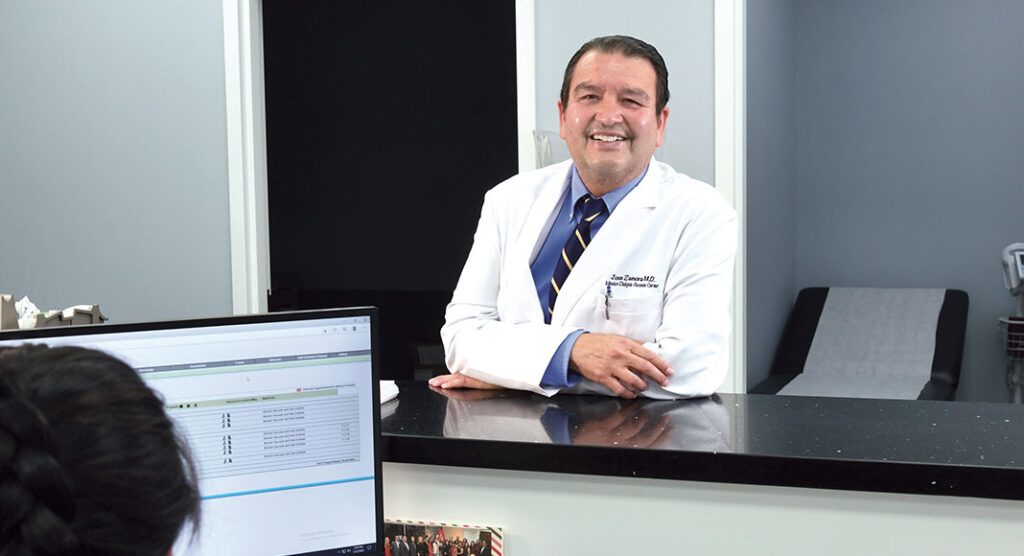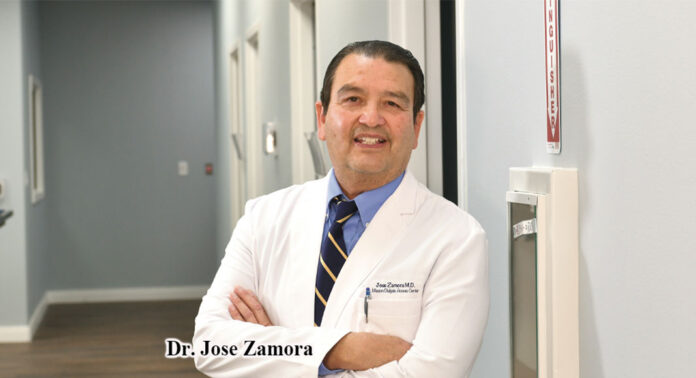Mega Doctor News
By Roberto Hugo Gonzalez
What is Hemodialysis Access?
Let us introduce you to the Mission Dialysis Access Center (MDAC), the first outpatient dialysis access center in the McAllen/Mission area. “Our purpose is to keep the lifeline of patients up and running,” stated Dr. Jose Zamora.
The kidney is an organ that removes waste products from the bloodstream. Uncontrolled diabetes, hypertension, and chronic kidney diseases can lead to an advanced stage of kidney failure. When the kidneys fail, the waste products remain in the blood making the patient very ill, this becomes a life-or-death situation for many. At that point, the patient is offered the benefit of an artificial kidney machine and a process called hemodialysis (HD).
Hemodialysis has maintained patients alive for many years. In general, the artificial kidney is like a washing machine, it takes the dirty blood in large amounts, filters it outside the body, and returns the filtered blood to the patient. This process requires an average of three sessions of three to four hours per week. “It becomes the patient’s lifeline,” as Dr. Zamora says.
Hemodialysis requires a connection to the body through an ‘access site’. This access site is a device that makes a large amount of blood available to be cleaned by the machine. It comes in different forms; it can be temporal such as a catheter, or a long-term access, such as an Arterio-Venous Graft or Fistula (AV Graft or AV Fistula).
These access sites can develop a clot or scar tissue and tend to fail. If the access site doesn’t work, the person’s health can deteriorate very quickly. It is a condition that must be corrected promptly because a person can only survive without properly functioning kidneys for a short time. That is why it is essential to manage this access site appropriately.
When the access site fails, most patients are sent from the hemodialysis center to a local hospital. Usually, it takes a two-to-three-day stay in the hospital to resolve this condition. The patient will receive hemodialysis in the hospital. Some patients are discharged with a new temporal catheter and then they need to follow up with a surgeon for a new AV Graft or Fistula creation.
Mission Dialysis Access Center offers an alternative to this condition. The correction can be performed in an outpatient setting and avoiding hospitalization. They try to preserve the current hemodialysis access site to avoid a new surgery. Usually, the patient can return to their established hemodialysis clinic the same day or the day after. This outpatient management is the standard of care in most major cities.
“Ideally, we should not wait for the access site to occlude completely. These patients should be monitored, and the access site malfunction should be discovered before progressing to a complete blockage. The wear and tear of using the access site may eventually lead to a malfunction. At MDAC, we offer access site surveillance, because it is better to fix an access issue before it is occluded,” Dr. Zamora explained.

MDAC has two physicians on staff:
Dr. Jose Zamora, a vascular specialist with experience in Cardiovascular Surgery and Dr. Pedro Mego, a board-certified interventional cardiologist. Dr. Zamora is board certified by the American Board of Surgery and a diplomate of the American Board of Thoracic Surgery. His primary interest is in dialysis procedures. Dr. Zamora trained under Dr. Michael DeBakey and has published scientific articles on subjects related to dialysis.
Dr. Pedro Mego is an Interventional cardiologist and Endovascular Diplomate of the American Board of Vascular Medicine. He has dedicated his professional life to treating coronary artery disease (CAD), peripheral artery disease (PAD), and chronic venous disease (CVD). His primary interest is avoiding amputations, especially in high-risk populations such as patients with hemodialysis.
The purpose of the Mission Dialysis Access Center is to maintain the proper function of the dialysis access device. The clinic does not administer dialysis; it only provides service to maintain the dialysis access site in good working order.
Dr. Zamora mentioned that the patients on hemodialysis must go three times a week to spend three to four hours attached to the dialysis machine.
“We, at MDAC understand that our patients are experiencing stressful situations due to their illness. We are proud to offer our services in an outpatient setting with state-of-the-art equipment,” he said.
Through his practice at the Mission Dialysis Access Center, Dr. Jose Zamora provides evaluations for the creation, surveillance, and functional maintenance of hemodialysis with minimally invasive technology.
The most common procedures performed at MDAC are:
- Insertion/Removal of temporal dialysis catheter,
- Radiologic evaluation of AV Fistula or Graft,
- Angioplasty of AV Fistula or Graft,
- Percutaneous thrombectomy (de-clotting) of a clotted access,
- Surgical creation of AV Fistula or Graft,
- Non-surgical creation of Ellipsys® AV Fistula (percutaneous, minimally invasive) for patients that meet specific criteria.
Dr. Zamora is originally from Mexico and has been in this country for 46 years. He has had ten years of training; five years at the University of Illinois in Chicago, three years at the Baylor College of Medicine in Houston, Texas, and two years at State University of New York, in Syracuse. In 1994, he moved his practice to the Rio Grande Valley.
In their most recent professional endeavor, Dr. Zamora associated with Dr. Mego, created the first endovascular Ellipsys® AV Fistula in the RGV. The Ellipsys® device is revolutionizing the management of dialysis patients. It is performed in an outpatient setting with needles, wires, and catheters expertise (endovascular). It is a top-notch technology; this procedure has excellent short-term advantages avoiding a surgical scar, minimizing pain, and post-surgical complications. The latest published reports on the Ellipsys® show outstanding long-term success.
Both doctors are committed to offering high-quality treatment with respect and compassion for their renal patients. The staff at MDAC is keenly aware of the great deal of suffering that affects those who have lost the function of their kidneys and now require dialysis. The Mission Dialysis Access Center transfers the sophistication from the hospital to an outpatient setting with more comfort for the patient.
“Residents of the Rio Grande Valley sometimes fear that doctors may give them bad news and they would rather not go to the doctor until it’s too late. Our goal is to improve public education and maintain a better state of health in the community,” Dr. Zamora concluded.
For more information call (956) 997-6111; Mission Dialysis Access Center is located at 1317 St. Claire Blvd., Suite A5 in Mission, Texas 78577.












